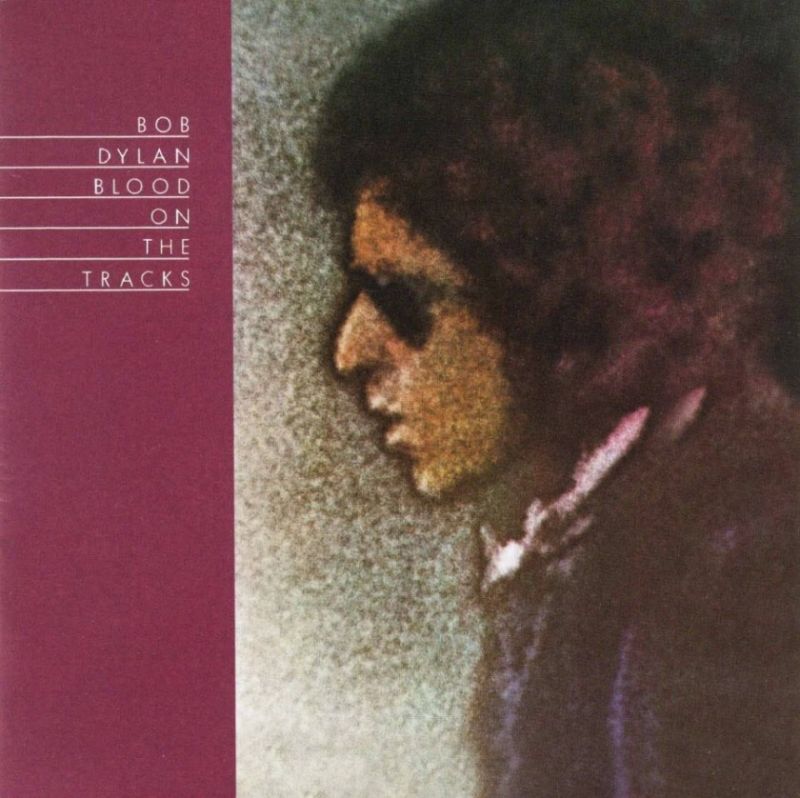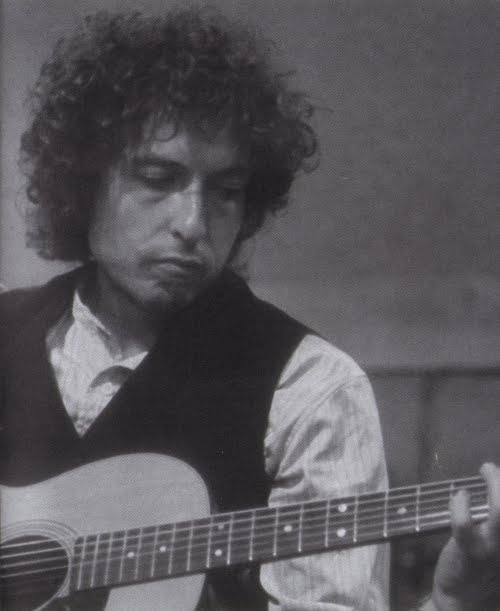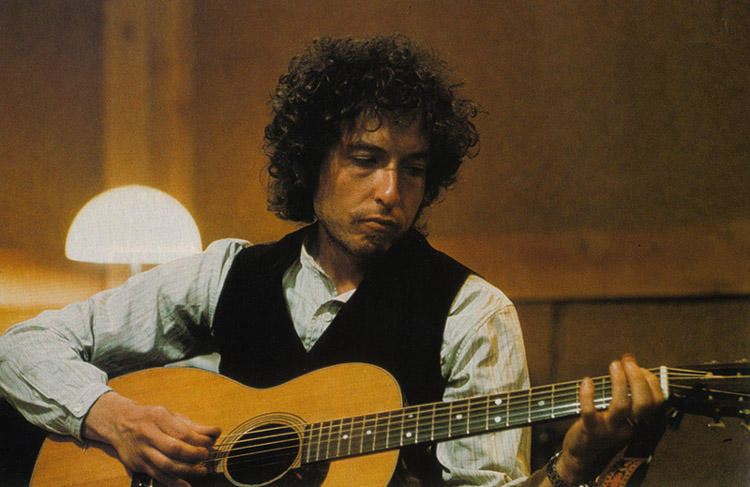[vc_row][vc_column][vc_message message_box_color=”mulled_wine” icon_fontawesome=”fa fa-quote-left”]A lot of people tell me they enjoy that album. It’s hard for me to relate to that. I mean, you know, people enjoying the type of pain, you know.
~Bob Dylan (to Mary Travers April 1975)
Well, Blood On The Tracks did consciously what I used to do unconsciously. I didn’t perform it well, I didn’t have the power to perform it well, but I did write the songs; they can be changed but the idea was right…
~Bob Dylan (to Matt Damsker, September 1978)
–
In stunning, total contrast to the previous album, Before the Flood, this 16th Dylan album triumphantly shows more subtlety and nuance than anything he’d ever done, and as honed a use of understatement as on John Wesley Harding. At the time this was the most unexpected leap of Dylan’s career. After years of comparatively second-rate work and a considerable decline in his reputation, here was an album to stand with Highway 61 Revisited and Blonde on Blonde.
~Michael Gray (The Bob Dylan Encyclopedia)[/vc_message][/vc_column][/vc_row]
[vc_row][vc_column][vc_message message_box_color=”mulled_wine” icon_fontawesome=”fa fa-quote-left”]Early one mornin’ the sun was shinin’
I was layin’ in bed
Wond’rin’ if she’d changed at all
If her hair was still red
Her folks they said our lives together
Sure was gonna be rough
They never did like Mama’s homemade dress
Papa’s bankbook wasn’t big enough
And I was standin’ on the side of the road
Rain fallin’ on my shoes
Heading out for the East Coast
Lord knows I’ve paid some dues gettin’ through[/vc_message][/vc_column][/vc_row]
Tangled up in blue
[vc_row][vc_column][vc_message message_box_color=”mulled_wine” icon_fontawesome=”fa fa-quote-left”]Jonathan Cott: So what are the songs on Blood On The Tracks about?
Bob Dylan: The present.
~Jonathan Cott interview December 1977[/vc_message][/vc_column][/vc_row]
Wikipedia:
| Released | January 20, 1975 |
|---|---|
| Recorded | September 16–19, 1974, at A&R Recording in New York, New York and December 27–30, 1974, at Sound 80 in Minneapolis, Minnesota |
| Genre | Folk rock |
| Length | 51:42 |
| Label | Columbia |
| Producer | Bob Dylan |
Blood on the Tracks is the fifteenth studio album by American singer-songwriter Bob Dylan, released in January 1975 on Columbia Records. The album marked Dylan’s return to Columbia after a two-album stint with Asylum Records. Most of the lyrics on the album revolve around heartache, anger, and loneliness.
The album, which followed on the resurgence of critical acclaim for Dylan’s work after Planet Waves, was greeted enthusiastically by fans and critics. In the years following its release it has come to be regarded as one of his best albums; it is common for subsequent records to be labeled his “best since Blood on the Tracks.” It is also commonly seen as a standard for confessional singer-songwriter albums; though Dylan has denied that the songs are autobiographical, his son Jakob Dylan has stated: “The songs are my parents talking.” In 2003, the album was ranked number 16 on Rolling Stone‘s list of the 500 greatest albums of all time, and in 2004, it was placed at number 5 on Pitchfork Media‘s list of the top 100 albums of the 1970s.
The album reached #1 on the Billboard 200 charts and #4 on the UK Albums Chart. The single “Tangled Up in Blue” peaked at #31 on the Billboard Hot 100 singles chart. The album remains one of Dylan’s best-selling studio releases, with a double-platinum US certification by the Recording Industry Association of America (RIAA).
[vc_row][vc_column][vc_message message_box_color=”mulled_wine” icon_fontawesome=”fa fa-quote-left”][The real] wonder is in the spaces, in what the artist’s left out of his painting. To me, that has always been the key to Dylan’s art. To state things plainly is the function of journalism; but Dylan sings a more fugitive song: allusive, symbolic, full of imagery and ellipses, and by leaving things out, he allows us the grand privilege of creating along with him. His song becomes our song because we live in those spaces. If we listen, if we work at it, we fill up the mystery, we expand and inhabit the work of art. It is the most democratic form of creation
~Peter Hamill (liner notes to BOTT)[/vc_message][/vc_column][/vc_row]
[vc_row][vc_column][vc_message message_box_color=”mulled_wine” icon_fontawesome=”fa fa-quote-left”]‘Simple Twist of Fate’ is another absolutely extraordinary performance. Where ‘Tangled Up In Blue’ is bright, bouncy, jangly, ‘Simple Twist Of Fate’ is soft and warm and mournful. Dylan’s voice is.. gentle and rounded.
~Paul Williams (Bob Dylan: Performing Artist, Vol 2: The Middle Years 1974-1986)[/vc_message][/vc_column][/vc_row]
Simple Twist of Fate:
[vc_row][vc_column][vc_message message_box_color=”mulled_wine” icon_fontawesome=”fa fa-quote-left”]‘A unique combination of a new interest in open tunings (inspired by JONI MITCHELL), a new perspective on writing and time (inspired by the mysterious art-teacher NORMAN RAEBEN), and a broken heart (inspired by SARA [DYLAN]), brought about a burst of creative energy comparable only to the making of his mid-sixties trilogy.’
~Eyolf Østrem (on Blood On The Tracks)[/vc_message][/vc_column][/vc_row]
Pre-production
Prior to recording, and while details regarding his return to Columbia Records were being fleshed out, Dylan previewed the songs that would make up Blood on the Tracks to a number of friends and peers in the music world. According to biographer Jimmy McDonough, Dylan visited Neil Young in his home in Florida to showcase the songs on the album and seek out Young’s opinion, and even run through some of the songs with Young’s group Crazy Horse. Dylan also previewed the songs to David Crosby, Graham Nash, Stephen Stills, Tim Drummond, and Peter Rowan. Notably, Graham Nash recalled that Stephen Stills disliked Dylan’s private performance of his new songs: immediately after Dylan left the room, Stills remarked to Nash, “He’s a good songwriter…but he’s no musician.”
Recording sessions
Dylan arrived at Columbia Records’ A&R Recording Studios in New York City on September 16, 1974, where it was soon realized that he was taking a “spontaneous” approach to recording. The session engineer at the time, Phil Ramone, later said that he would “go from one song to another like a medley.
Prev posts on Blood On The Tracks recording sessions:
- Blood On The Tracks – First recording session, 16 September 1974
- Blood On The Tracks, Second Recording Session, 17 September 1974
- Blood On The Tracks, 4th Recording Session, 19 September 1974
- Blood On The Tracks, 5th recording session 27 Dec 1974
- Blood On The Tracks, 6th & final recording session 30 Dec 1974
[vc_row][vc_column][vc_message message_box_color=”mulled_wine” icon_fontawesome=”fa fa-quote-left”]I once read a book of Nathaniel Hawthorne’s letters to some girl, and they were extremely private and personal, and I didn’t feel there was any of myself in those letters, but I could identify with what he was saying. A lot of myself crosses over into my songs. I’ll write something and say to myself, I can change this, I can make this not so personal, and at other times I’ll say, I think I’ll leave this on a personal level, and if somebody wants to peek at it and make up their own minds about what kind of character I am, that’s up to them. Other times I might say, well, it’s too personal, I think I’ll turn the corner on it, because why do I want somebody thinking about what I’m thinking about, especially if it’s not to their benefit.
~Bob Dylan (to Scott Cohen, Sept 1985)[/vc_message][/vc_column][/vc_row]
Track listing
All songs written by Bob Dylan
- “Tangled Up in Blue” December 30, 1974 at Sound 80 in Minneapolis, Minnesota
- “Simple Twist of Fate” September 19, 1974 at A&R Recording in New York, New York
- “You’re a Big Girl Now” December 27, 1974 at Sound 80 in Minneapolis, Minnesota
- “Idiot Wind” December 27, 1974 at Sound 80 in Minneapolis, Minnesota
- “You’re Gonna Make Me Lonesome When You Go” September 17, 1974 at A&R Recording in New York, New York
– - “Meet Me in the Morning” September 16, 1974 at A&R Recording in New York, New York
- “Lily, Rosemary and the Jack of Hearts” December 30, 1974 at Sound 80 in Minneapolis, Minnesota
- “If You See Her, Say Hello” December 30, 1974 at Sound 80 in Minneapolis, Minnesota
- “Shelter from the Storm” September 17, 1974 at A&R Recording in New York, New York
- “Buckets of Rain” September 19, 1974 at A&R Recording in New York, New York
[vc_row][vc_column][vc_message message_box_color=”mulled_wine” icon_fontawesome=”fa fa-quote-left”]The first version of this album struck me as a sellout to the memory of Dylan’s pre-electric period; this remix, utilizing unknown Minneapolis studio musicians who impose nothing beyond a certain anonymous brightness on the proceedings, recapitulates the strengths of that period. Dylan’s new stance is as disconcerting as all the previous ones, but the quickest and deepest surprise is in the music itself. By second hearing its loveliness is almost literally haunting, an aural déjà vu. There are moments of anger that seem callow, and the prevailing theme of interrupted love recalls adolescent woes, but on the whole this is the man’s most mature and assured record.
~Robert Christgau[/vc_message][/vc_column][/vc_row]
Personnel
All personnel credits adapted from the album’s liner notes.
- Bob Dylan – vocals, guitar, harmonica, organ, mandolin, production
- Additional musicians
- Bill Berg – drums[A]
- Charles Brown, III – guitar[B]
- Tony Brown – bass guitar[B]
- Buddy Cage – steel guitar[B]
- Richard Crooks – drums[B]
- Paul Griffin – organ, keyboards[B]
- Gregg Inhofer – keyboards[A]
- Barry Kornfeld – guitar[B]
- Thomas McFaul – keyboards[B]
- Kevin Odegard – guitar[A]
- Peter Ostroushko – mandolin[A]
- Billy Peterson – bass guitar[A]
- Chris Weber – guitar, 12-string guitar[A]
- Eric Weissberg – banjo, guitar[B]
- A Denotes personnel performing at the Minneapolis recording sessions.
- B Denotes personnel performing at the New York recording sessions.
[vc_row][vc_column][vc_separator][vc_btn title=”Alldylan / Borntolisten @ Facebook” color=”blue” i_icon_fontawesome=”fa fa-facebook-official” add_icon=”true” link=”url:https%3A%2F%2Fwww.facebook.com%2FJohannasVisions%2F||target:%20_blank|”][/vc_column][/vc_row][vc_row][vc_column][vc_message message_box_style=”outline” icon_fontawesome=”fa fa-link” css_animation=”bounceIn”]
Check out:
- Bob Dylan album posts @ alldylan.com
- Tangled Up in Blue
- Idiot Wind (New York version)
- Shelter From The Storm
- Up To Me
- Simple Twist of Fate
- If You See Her, Say Hello
- –
- Karl Erik’s expectingrain.com
- Olof’s “Still On The Road“
[/vc_message][/vc_column][/vc_row]
-Egil





It is 43 years ago, the album was published. And it is still exciting to listen too and it hasn’t lost anything of its qualities since then.
“Blood in the tracks” is more than a great album, it is the peak of cultural epoch, like the Pyramids or the music of Mozart.
Whatever one will remember about popular culture if the 20th century in let’s say 300 years “Blood on the tracks” will be one of the artefacts human beings (or the cyborg artificial intelligence hybrids that have replaced them) will listen to “Tangled Up in Blue”, “Simple Twist of Fate” and “Shelter from the storm”.
The tunes Dylan found to express the emotional pain of these times he used are still unmatched in their simple, but mysterious openness to so many different interpretations. When I am listening to complete concerts I first watch the setlists if one of the three tunes above appear. “Blood on the tracks” is Bob Dylans gift to mankind (as his whole work is), but there is no other album where he emphasized more the fragile emotional fabric of the human condition. Everyone can imagine the same emotional despair, but Dylans different interpretations of these tunes gave me solace like on one can do.
when i first heard this album it felt as if someone had hog-tied me and dragged me into a new place in my life, a place where pain and beauty and understanding alternately scraped my soul raw. after about a thousand listenings, not much has changed.
what other records have used the same non-standard tuning throughout? when it says he recorded like a medley i identified as i have fallen in to doing the same with these songs